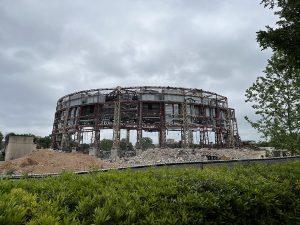Construction of the Special Events Center at the University of Texas at Austin officially began in August 1974. The facility opened November 29, 1977, with a double-header basketball game, the University of Texas women’s team played first against Temple Junior College and the men’s team faced Oklahoma later that night. However, construction wasn’t entirely complete that day, so center director Dean Justice required electricians, mechanics, and elevator operators to be on site while fans were in the building. Fortunately, there were no issues with the facility. Before tip-off, Longhorn head coach, Jody Conradt, and her players discussed how important it was that a Longhorn scored the first points in their new home arena, but that plan was quickly spoiled when Temple guard Evwella Munn made the first basket. Munn, however, eventually became a Longhorn—she transferred to Texas and played on the team for her senior season (1979-80)—so, ultimately, it is mostly true that a Longhorn scored the first points in the arena’s prestigious basketball history. Both Texas teams won, by the way. The women’s team beat Temple 67-64 and the men’s team defeated the Sooners 83-76.
The Special Events Center was the primary focus among several of the University’s expansion projects overseen by Frank C. Erwin, Jr., a local lawyer with friends in high places, and who served as chairman of the UT System Board of Regents from 1966 to 1971. He remained a Regent until 1975. Considered controversial for his conservative views, Erwin sought to expel students that protested the Viet Nam War and oversaw the arrest of students protesting the removal of trees along Waller Creek during the expansion of Texas Memorial Football Stadium in 1969. The original construction cost for the 97,000 square foot basketball palace was $34 million. Wilson, Crain & Anderson, the architectural firm of Astrodome fame, designed the building. It’s round concrete façade and 400-foot diameter flat top resembled Big Bertha, the massive bass drum wheeled around by the University of Texas marching band, therefore, it is no surprise that the Event Center was known, colloquially, as “the super-drum” or simply as “the drum.” Erwin passed away October 1, 1980, but the Special Events Center was renamed in his honor before the end of the year.
The Erwin Center replaced Gregory Gymnasium as the home court for both the men’s and women’s basketball teams at the University of Texas. With approximately 17,000 seats, it more than doubled the capacity of the smaller and more intimate Greg Gym. The University Interscholastic League (UIL), which operates as the governing body of high school sports and competition in the state of Texas, was also able to call the Erwin Center home for all of its boys’ and girls’ state championship basketball games. From its opening until 2015 when championship games were moved to San Antonio, the greatest hoopers in the state ended their basketball seasons in the Erwin Center. Perhaps the most dominant player and best-known today was Shaquille O’Neal, whose parents served in the United States military. When his parents were stationed in San Antonio during his senior year of high school, the young “Diesel” led Cole High School to the 3A Texas State Championship in 1989. Charles Breithaupt, the UIL’s executive director, called O’Neal the “greatest player to ever play” in the Texas state tournament. Looking back, Shaq was arguably the best high school basketball player in Texas history and certainly the best high school player to ever play at the Erwin Center. He, of course, went on to have a stellar career in the NCAA and the NBA.
The draw of the Erwin Center wasn’t just the creation of an immense basketball arena. It also gave the city of Austin the ability to draw in large music acts and concert tours, plus other special programming. Lawrence Welk was the first music act at the Erwin Center on March 12, 1978. While not a pop star, Welk was a reliable ticket-seller, and the house sold out for the inaugural concert (15,676 in attendance). The largest sell out ever was for John Denver, who performed a few months later in front of a crowd of 17,829. Because Denver opted to perform on a 24-foot by 24-foot stage, there was more room for floor seating. As a result, that attendance record was never broken. And there have been many more significant music and entertainment events since. The Ringling Bros. Circus and the Harlem Globetrotters were mainstays throughout the life of the Frank Erwin Center. The Globetrotters were the final ticketed event on April 2, 2022. Other notable events include a boxing match between Jesus Chavez and Tom Johnson in 2001, the 2011 Davis Cup tennis tournament, football coach Darrell Royal’s public memorial service, countless high school and college graduations, speeches by notable speakers such as U.S. President Clinton and His Holiness the Dalai Lama, and President George W. Bush’s announcement of his presidential campaign.
Deconstruction of the Frank Erwin Center began November 2023. Rather than use explosives, the arena was taken apart piece-by-piece due to mold issues that posed a safety risk and the ability to recycle more of the materials. Over the course of several months, the drum seemed to recede back to a skeletal form, showcasing more and more of its base geometry, until nothing stood on the site anymore. This exhibit is curated from photo plaques that were displayed inside the Frank Erwin Center to honor significant moments and events. The Stark Center has partnered with Texas Athletics in preserving much of the important history that happened inside the Drum.




